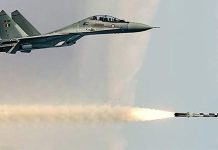The Chengdu J-7 has been the most capable fighter in the PLAAF since the late 1960s, and to this day it has not been decommissioned.
The design of the J-7 was based on the MiG-21 fighter from the Soviet Union, which served in the Soviet Air Force in 1959. The original J-7s were much inferior to the original Soviet models. The Chinese invested heavily in this design and made it a formidable fighter.
Production of the J-7 continued until 2013. Although the design was gradually replaced by more advanced platforms such as the domestic J-10A and J-11B from the early 2010s, the J-7 is still appreciated for its low operating cost and ease of maintenance.
The J-7G represents the most advanced variant of the J-7 fighter line. It has a much higher rate of composite material usage compared to the first generations. It features an all-glass cockpit, new double delta wings, three multifunctional HUD screens and hands on throttle-and-stick control (HOTAS.)
The equipment of a modern fighter has also been added such as: enhanced flight vision system, reduced radar cross-section and improved fuel tank, and additional features of fourth generation fighters.
While the J-10 is in service as a light single-engine fighter, the J-7G can be classified as an “ultralight” fighter, which the PLAAF does not use in combat missions. A significant number of J-7s have been retired in recent years, to switch to J-10 or even more advanced and heavier fighters like the J-16, which three times as large.
It makes sense to withdraw a J-7G squadon from the front line for training. The outdated fighters will gradually be replaced by more advanced 4+ and 4++ generation aircraft. Although many countries have stopped using the Mig-21 and J-7, they are still useful in the PLAAF.






















